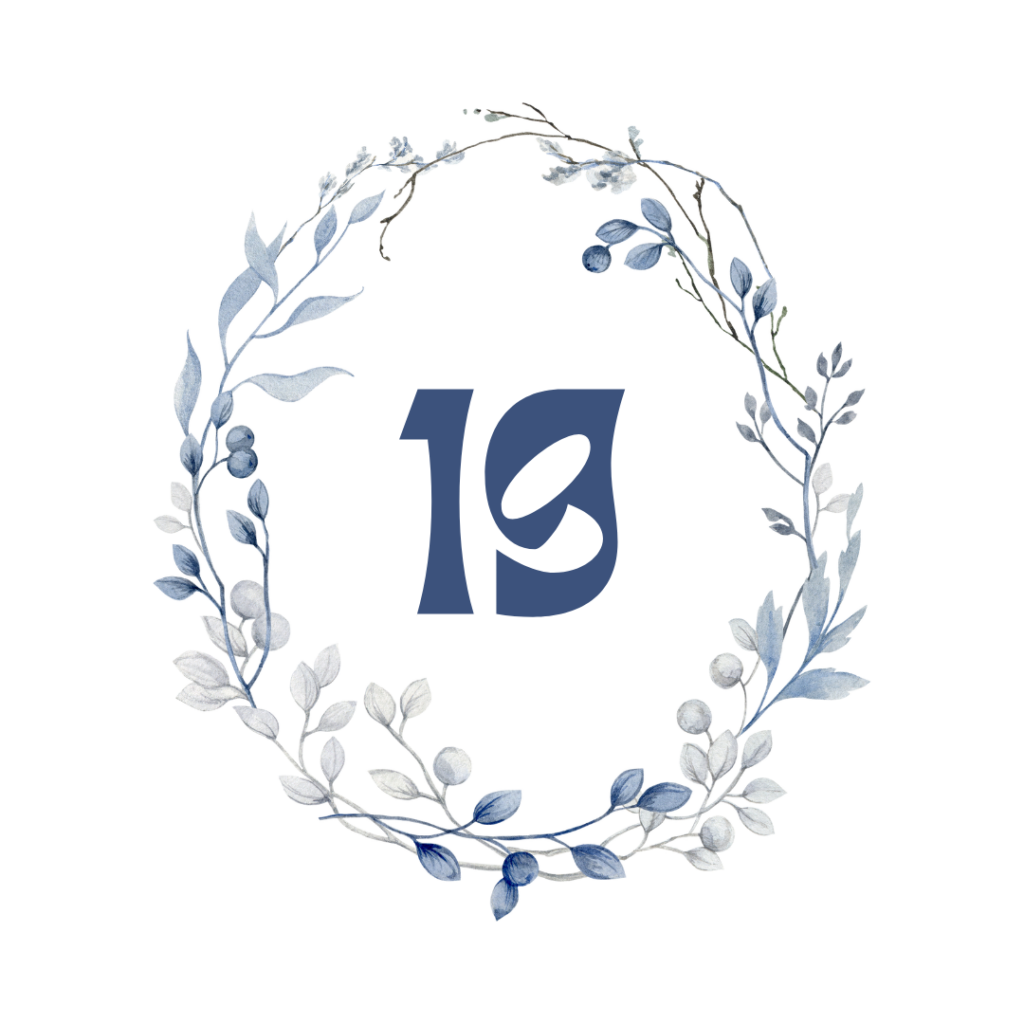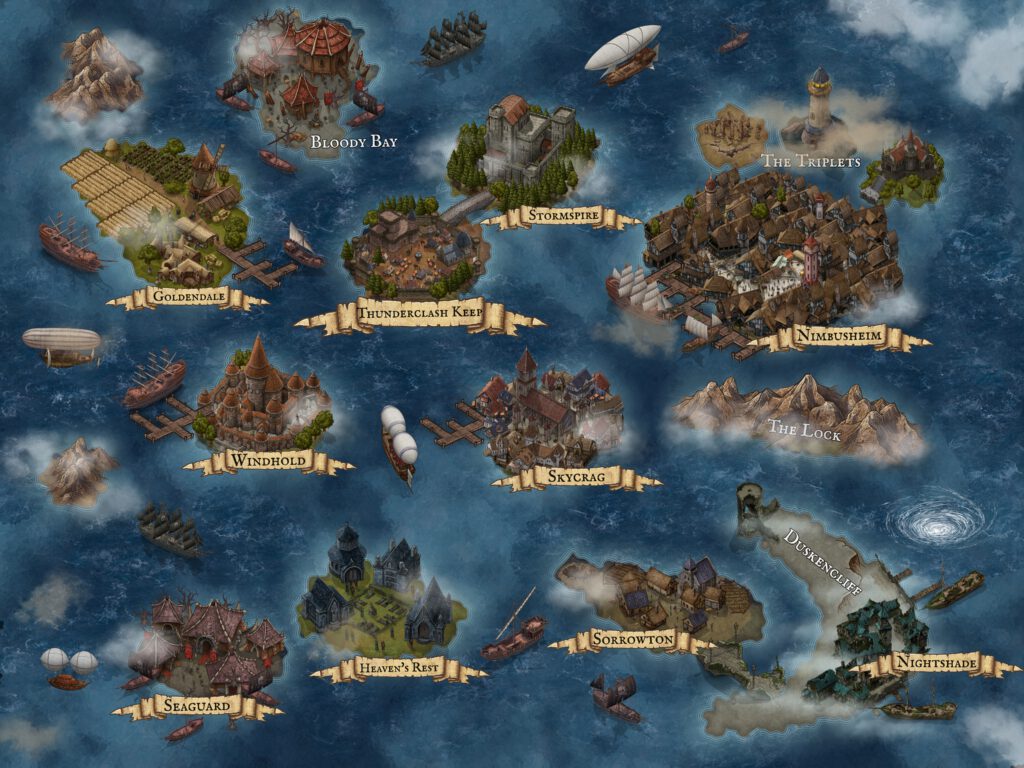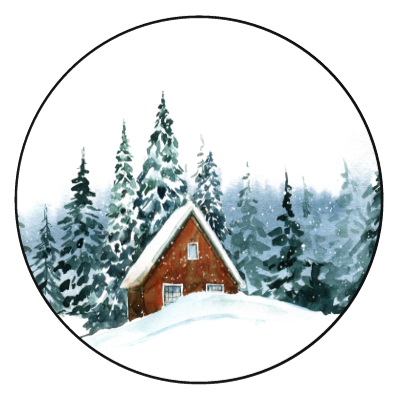























Prolog

How strange are all the stories I have collected while travelling the Cloud Islands – but none are as strange as the one I encountered on the crossing to Himmelsruh. ‘Encountered’ is the proper term in this case, as the man I received it from stumbled straight into my tranquil afternoon tea with his tale.
It was a glorious autumn day with a crisp blue sky, the trees were shades of gold and red as the Nubifer slowly lifted off the dock and took to the air. The streets of Skycrag below us shrank rapidly, the waving people soon becoming nothing more than tiny blurred dots. I was just enjoying the view of the tiled roofs and the pointed spire of the great cathedral, sipping a hot cup of wind tea with glee and letting my gaze wander, when I was suddenly bumped hard on the arm. The steaming liquid sloshed over my hand and scalded me – I looked up in annoyance. ‘Oh, please forgive me!’ The man who had pushed me immediately grabbed my napkin and helped me to wipe up the spill. Then he joined me at the table. “You look like you could do with some company,” he said and I almost sent him packing because of his audacity. But something inside me held me back and today I am grateful for this level-headedness. “What gives you that impression?” I replied, scrutinising my counterpart for the first time. His affiliation with the Navigators‘ Guild was unmistakable. Anyone who didn’t notice the pendant in the shape of a compass rose could tell from the silver embroidered steel grey lining of his uniform jacket that he was the right person for storm zones. Among the navigators, the different colours indicate their specialisation, for example those who can safely navigate by night wear dark blue and those who mainly fly trade routes prefer gold. My neighbour at the table also wore the mark of his guild clearly on his face. A red ring around his left eye bore witness to the miniature binoculars that he wore like a monocle when practising his profession.
„You look like a sponge,“ he declared. I almost protested again in indignation, but he continued: „Like a human sponge that tries to soak up everything its surroundings have to offer. You’re a story collector.“ „What makes you think that?“ I asked. Now he looked at me closely. ‘Well, that’s not difficult,’ he said, pointing at me with an elegant gesture. „You have ink stains on the cuffs of your sleeves, notepaper rustles in your pockets when you move and you have the unmistakable analytical look of a representative of the writing profession when you just examined me. I have something for you, so I said you could do with some company – namely mine.“ ‘Another tea, please,’ I called out to a passing waiter, ‘and whatever the gentleman is ordering.’ „For me, a fog milk.“ Well, I could have guessed that: The creamy white, almost transparent drink made from the milk of fog deer was a favourite among navigators and pilots. It was said to have a calming effect on the mind and sharpen the senses – but perhaps its popularity was only due to its sweet, slightly minty flavour, which came from the mist flowers that the animals found on the higher cloud islands.
As our drinks arrived, I asked the stranger his name. ‘Zacharias Morningstar,’ he said a little too quickly and I told him straight up that I would like to know his real name. He chuckled. ‘You never know who you’re going to meet, so I’ve made a habit of using an alias. But I guess I can’t fool you. Just call me Finn. My surname doesn’t matter.’ ‘Gladly,’ I said, ’and you have a story for me?’ ‘Indeed,’ said Finn, ’it’s the best kind of story. It’s a true one.“ ‘Then I’m your loyal listener,’ I replied and pulled out my notepad, ’it’s no problem if I…?’ ‘No, feel free to write everything down,’ he nodded, then his gaze suddenly became thoughtful. ‘It’s long past time for this story to be told.’
The following writings have been brought into a certain ‘form’ by my hand. Here and there I have taken the liberty of adding the odd word, thought and perhaps an action or two to my characters. But the story as such draws on the source of reality. I am a story teller and therefore committed above all to my own creative mind. Nevertheless, I also strive to document the experiences of my many endeavours as truthfully as possible. I don’t know what it is that makes true stories so appealing to my readership, but they wring them from my pen with a passion like a thirsty man wringing water from a coconut. For this reason, what I have written here is not only based on the testimony of the navigator Finn, I also met other of his companions on his advice and looked up the birth records of those involved in the central archives of Temple Island. In this way, I was at least able to verify that all the protagonists who experience the most outlandish adventures on the following pages actually inhabited the Cloud Islands at the same time. I also tried to verify the probability of what I was told and trained myself in the field of aeronautics as best I could: I spent a semester attending lectures at the University of Applied Flying Arts, hanging out in the aviation pubs near the harbour and attending the public meetings of the island administration that dealt with air piracy. On a visit to the Great Library of Nimbusheim to read up on the tactics and manoeuvres of air combat in a strategic manual, I discovered an impressive collection of works on the dusty shelves: The Art of the Sky explained the rules and etiquette of air travel, while the Navigators‘ Compendium taught the basics of aerial navigation and, above all, contained regulations and rules of behaviour that all pilots and navigators must know. The apparently rather thin booklet Compass of the Wind delved surprisingly deeply into the subject of currents and storm zones and the tome Zeppelin’s Legacy revealed to me the history of sky travellers. As well as an Atlas of Celestial Routes, which described trade routes, I also found The Secrets of the Floating Gardens, a unique work on the flora of the Cloud Islands, which is particularly useful for airship crews trading in exotic plants or herbs. I buried myself in the pages for days and at some point I smelled a mixture of leather bindings, old paper and book dust.
As I don’t know how you feel about travelling, dear reader, I would like to take this opportunity to speak a few words about the Cloud Islands. If you have not yet seen them for yourself, I warmly recommend them to you. Their sheer variety is enough to take a visitor’s breath away. The golden fields of Goldendale stretch out in the air like a living flying carpet, the magnificent Windhold towers proudly above the clouds with its sharp battlements and the most beautiful markets and best traders can be found on Skycrag. The mighty castle Stormspire sits enthroned as a bulwark against approaching storms, opposite its twin island with the fortress Thunderclash Keep, where the Storm Knights are trained. The Floating Gardens on the cemetery island of Heaven’s Rest are just as worth seeing as the chapels and monasteries of the wind priests and Fratres Caelestis there, who are familiar with the unique burial rites of the Cloud Isles. The pirate village of Seaguard and the Bay of Blood have a wild and rugged charm, but should only be observed when flying over and from a sufficient distance – as should the deserted night city. Those who are not afraid of a thrill can visit the village of Sorrowton and familiarise themselves with its dark history. Finally, there is Nimbusheim, the capital of the islands, a labyrinth of countless doors, towers and winding alleyways.

Flying is not just a necessity in this world, but an art that has filled the skies above the cloud islands with a fascinating variety of machines and constructions. Large merchant ships, majestic and sluggish, travel across the skies, transporting the harvests of the fields of high seed to the cities. In between, shuttle ships criss-cross the airways, robust and nimble, transporting the inhabitants safely and reliably from island to island. For passengers looking for something special, luxurious zeppelins with cabins and panoramic windows offer a stylish way to travel through the skies. Next to these giants hover silently hot air balloons, carried smoothly by the winds, which are mainly used by travellers who prefer to take their time to enjoy the breathtaking beauty of the cloudscapes.
But the celestial sea is also animated by smaller, manoeuvrable machines, for which there exist only names on the Cloud Islands. Skyswifts glide through the air as nimbly as swallows, light single-seaters with manoeuvrable wings that are particularly popular among messengers. Stormsails, special gliders with robust canvas, defy the turbulence of the storm zones and are mainly used by the Tempestarii, the guild of storm tamers. There are also Leviathans – heavily armoured, massive fighting machines that are used to protect the airways and defend the islands against pirate attacks. At every corner you will come across Whizboxes, small, hand-operated flying machines of various shapes and colours, which are used by children to slip quickly through the busy flight corridors. The most beautiful, however, are undoubtedly Starmoths, dainty biplanes with glass wings that glow in the twilight thanks to a special fabric and transform the sky into a sea of dancing lights at night.
There is so much more I could tell you, dear reader, who is inexperienced in the world of cloud islands: Of the complicated customs of greeting, which vary from island to island and can quickly lead to a disaster if done incorrectly. Of the exotic fabrics and weaving patterns that characterise the fashion of the Cloud Islands, from delicate haze fabric to dense storm leather. Of the strange superstitions that pilots adhere to – such as avoiding certain routes on full moon nights or throwing a hand of sand into the wind to favour the gods for a happy crossing. Of the closely guarded recipes for remedies brewed from the plants of the high fog to heal wounds faster or alleviate fear of flying. Of the magnificent festivals that are celebrated once a year in honour of the wind god Zephyros, during which free-fall jumps from the docks of the cloud islands take place in the day and the sky is lit up by flying fires in the evening. Of the extraordinary animal species such as shimmering twilight foxes or shy night shadows. Of the stories of the ancients who tell that the Cloud Islands were once solid ground before the skies lifted them up – and that one day they may sink again.
Yet descriptions of this kind are only capable of painting an abstract picture – let’s bring the world of the Cloud Islands to life!
